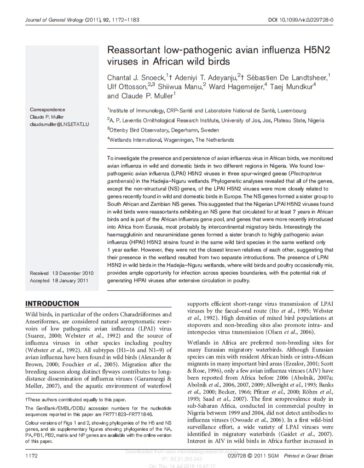
Low pathogenic avian influenza H5N2 virus in wild birds in Nigeria in Africa
-
Species
To investigate the presence and persistence of avian influenza virus in African birds, the authors of this paper monitored avian influenza in wild and domestic birds in two different regions in Nigeria. They found low pathogenic avian influenza (LPAI) H5N2 viruses in three spur-winged geese (Plectropterus gambensis) in the Hadejia–Nguru wetlands. Phylogenetic analyses revealed that all of the genes, except the non-structural (NS) genes, of the LPAI H5N2 viruses were more closely related to genes recently found in wild and domestic birds in Europe. The NS genes formed a sister group to South African and Zambian NS genes.
This suggested that the Nigerian LPAI H5N2 viruses found in wild birds were reassortants exhibiting an NS gene that circulated for at least 7 years in African birds and is part of the African influenza gene pool, and genes that were more recently introduced into Africa from Eurasia, most probably by intercontinental migratory birds. Interestingly the haemagglutinin and neuraminidase genes formed a sister branch to highly pathogenic avian influenza (HPAI) H5N2 strains found in the same wild bird species in the same wetland only 1 year earlier.
However, they were not the closest known relatives of each other, suggesting that their presence in the wetland resulted from two separate introductions. The presence of LPAI H5N2 in wild birds in the Hadejia–Nguru wetlands, where wild birds and poultry occasionally mix, provides ample opportunity for infection across species boundaries, with the potential risk of generating HPAI viruses after extensive circulation in poultry.
Citation: Snoeck, C.J., Adeyanju, A.T., De Landtsheer, S., Ottosson, U., Manu, S., Hagemeijer, W., Mundkur, T., Muller, C.P. (2011) Low pathogenic avian influenza H5N2 virus in wild birds in Nigeria in Africa. Journal of General Virology. 92, 1172–1183

